COVID19: How Covid-19 is altering the fashion world
23 min read

23 min read

by Aleksandra Stamatovic
Things that seemed certain at the beginning of 2020, such as the incredible, seemingly unstoppable rise of consumerism and the die-hard shopping habits, are no longer set in stone nor are they exempt from being put to test by the coronavirus crisis. But, why is it that only during a crisis we realize that anyone’s values can be tested? The pandemic has influenced almost every part of how people think, inevitably including their regular shopping habits and their overarching values regarding consumption, and their attitude towards the community.
The past year has to be the one that’s marked by the overall uptick in the use of the phrase “unprecedented times”, which became a run-off-the-mill talk when describing one of the biggest health crises that have hit the world. The impact of the Covid-19 pandemic has been heavily felt across the globe and is even more likely to run even deeper throughout the next couple of months and even years.
In tandem with the digital revolution, the fashion industry has experienced thriving interest and exponential changes in the way it works over the past decade or so. Unsurprisingly, the pandemic has uncovered the industries’ shortcomings and a growing number of voices are now questioning the complex way the fashion world works while lobbying for it to employ changes – fast.
In the last few months, we have witnessed enormous shifts in fashion. It’s evident that the industry and its consumers are becoming increasingly conscious of fashion consumption and are now on the lookout for new ways of doing things. Both consumers and producers are posing a question of finding a better, smarter side to fashion, which is leading to everyone rethinking the way our wardrobes are being used and not only, the way we consume fashion as a whole needs to be redefined. The post-pandemic world is leaning towards sustainability and what seems to be a better future for the world of fashion. Before we go into the details of the more conscious future of fashion, let’s get a glimpse of all the changes that have marked the past few years.
Before 2020, the world of fashion suffered some shocks but generally, fashion has been one of the past decade’s rare economic success stories. The industry showed a 5.5% annual growth according to the McKinsey Global Fashion index and has even been valued at an astonishing $2.4 trillion. Fashion is the world’s 7th largest economy if ranked alongside countries’ GDP.
Things get tough every once in a while and there are some scars and bruises that the industry carries with it as marks from some of the tougher years from the past. Before coronavirus, the epitome of a disaster year for the industry was 2016. Terrorist attacks in Paris, Brexit vote in the UK, and the overall volatility and fickleness of the Chinese stock market have created reverberating shocks to the global economy.
Right around the same time, consumers started becoming more demanding, more discerning, and have gone to great lengths making it hard to predict any of their shopping behaviors, as they were being radically reshaped by emerging tech innovations.
There is a common agreement that 2016 was one of the most challenging years for the industry but after it, there was a rather quick recovery and glimmers of hope were already visible in 2017 and 2018 projections.
Despite the initial thought of the fashion industry turning a corner in 2017, the rebound was not that quick nor was it equally redistributed across the globe. The year 2017 is considered to be an end of an era, to an extent, as Europe and North America stopped being the global stronghold for fashion sales. To speak to that, over 50% of the apparel and footwear sales are originating outside of the West and the primary sources of growth are emerging-market countries across Asia-Pacific, Latin America, and other non-Western regions.
Let’s just take a quick look at McKinsey’s fashion outlook report dating back to 2017 to see what their projections were like when it comes to the sales growth based on the markets.
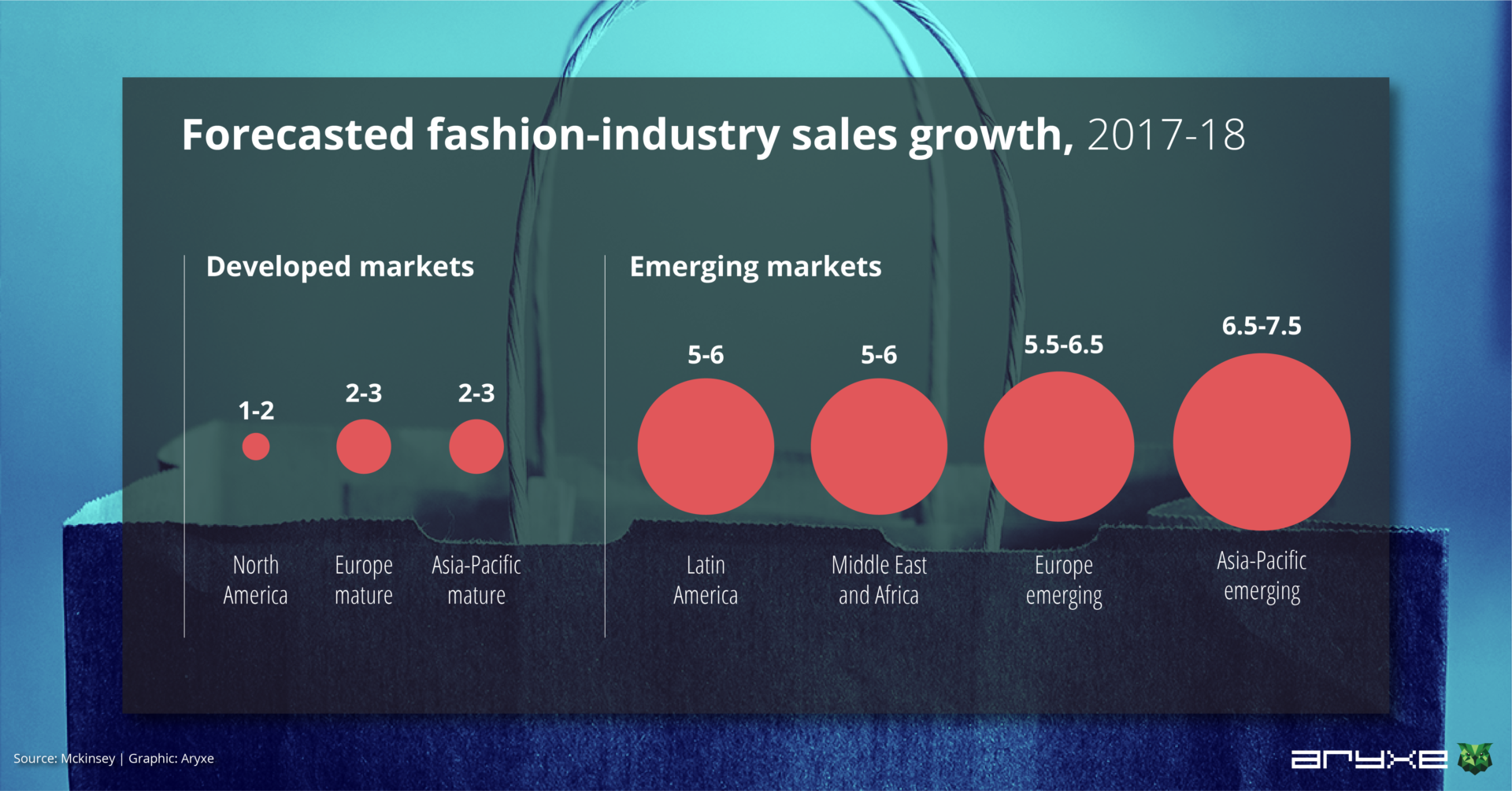
The changes took place alongside transformative shifts in customer behavior, as mainstream consumers turn to the decisive phase of the so-called digital adoption. Research shows that consumers in Southeast Asia spend almost eight hours a day online and the modern shopper’s mind is shaped by the comfort with digital channels and content that creates a complex customer journey across online and offline touchpoints. What consumers align on is an expectation of a consistent brand experience across channels. And, they have big hopes when it comes to customer service, carefully examining convenience, price, quality, and other important features that overall make a well-rounded shopping experience. Digital-first companies, such as Amazon, Zappos, and Alibaba started forcing fashion companies to care about providing a better shopping experience. Customers started adjusting to the expectation of immediate support at all times, rapid deliveries, and comfort above all.
The year 2019 was acclaimed to be the year of awakening. Forecasted growth was moving between 3.5% to 4.5%, which is slightly below the previous year’s figures. Geographically, the most optimistic about 2019 were the execs from the North American market. By segment, the most positive ones would be luxury brand executives. In all other segments and regions, executives are not that optimistic, reflecting the potential challenges that lie ahead.
Sales growth was projected to slow slightly for the fashion industry in many regions and segments as can be seen below. The red bars to the left represent the projections for 2018, while the yellow ones to the right show the growth expectations for 2019.

This chart paints a pretty clear picture showing how the Asia-Pacific mature and the Asia-Pacific emerging regions are intact and unimpacted by the drop in sales growth.

When it comes to the projections by Category, Apparel, Sportswear, Handbags, and luggage seemed to be categories that were escaping the impact of the drop in growth but all that was bound to change fairly soon with the unexpected pandemic being just around the corner.
The projections for 2020 were questionable even without being able to predict what will turn out to be an utterly gloomy year for the fashion industry among others. Before the pandemic started unraveling across the globe, executives were still seeing 2020 as a tough year due to many different factors, such as the digital shakeout gathering pace, consumers demanding more when it comes to sustainability, and overall sluggish growth, which is putting pressure on margins.
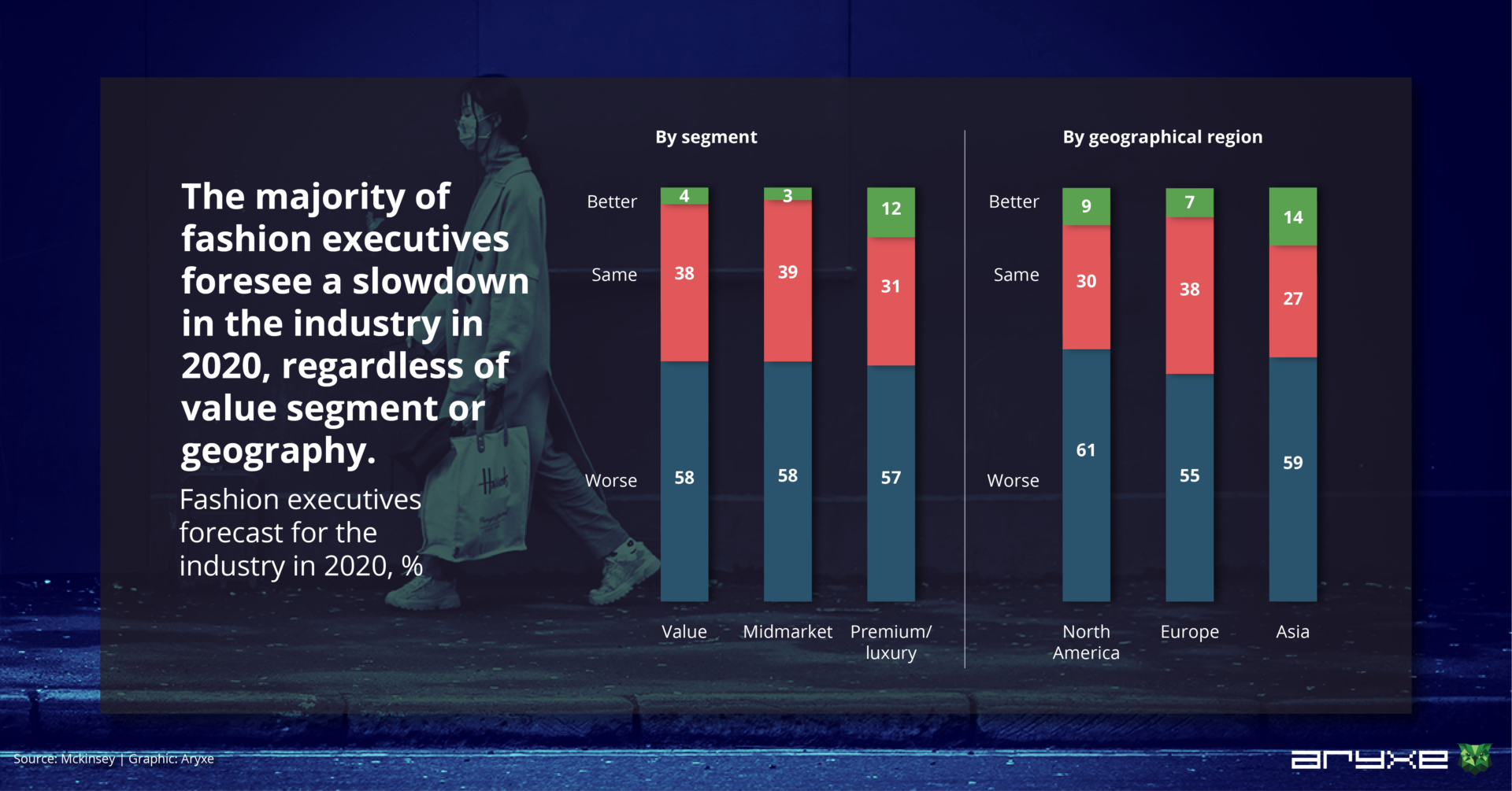
A little bit into 2020 and soon everyone started discerning that coronavirus could end up spurring the biggest economic contraction since WWII, hitting every single sector, from finance to hospitality. Fashion has shown to be extremely vulnerable and statistics show that the average market capitalization of apparel, fashion, and luxury big shots tanked almost 40% during Q1 only, which is a rather steep decline. And, let us repeat this, fashion is one of the biggest industries in the world, generating a jaw-dropping, $2.5 trillion in global annual revenues, which in itself entails joblessness and/or financial struggle for people across the value chain.
This projection from the beginning of 2020 shows exactly how dramatic the crisis was expected to be when it comes to its impact on the global fashion industry and its revenue.
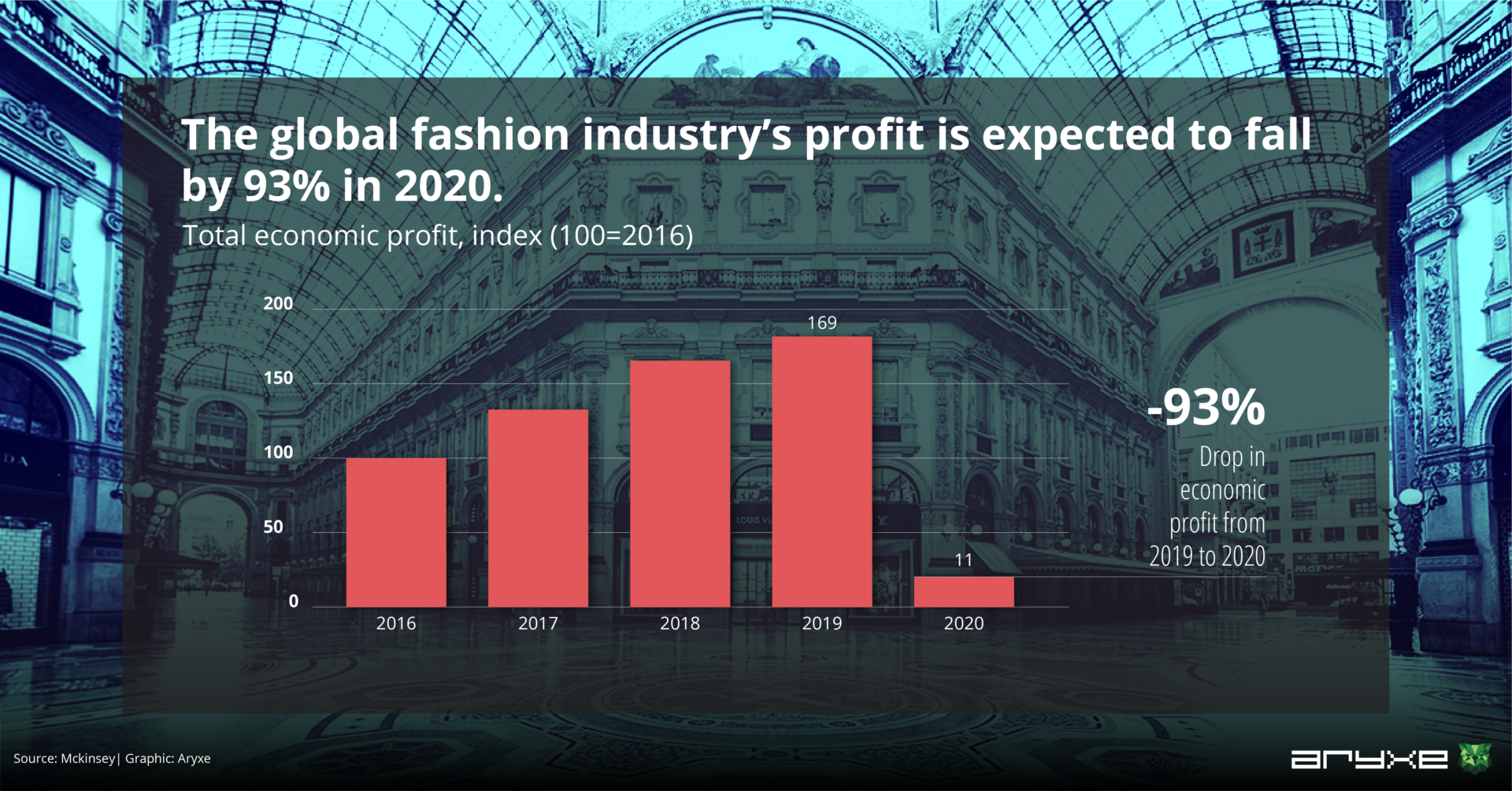
Decision-makers were tasked with a difficult job, managing the uncertainty for over a year now. The most successful ones are those that were able to get a grip on the trends that were shaping the fashion landscape throughout the crisis. Industry leaders who were able to focus on an omnichannel perspective, while focusing on the importance of sustainability are being rewarded with consumer (and clearly, investor) trust. On top of that, companies that were able to do all that while treating their workers and the environment with the utmost respect will be able to develop deeply rooted relationships with their customers.
Physical retail has been under historic levels of pressure. Only in the US, between 20,000 to 25,000 shops were expected to close down last year, which is more than a 50% increase from the year prior. With the gloomy projections, numerous brands decided to gear up and go full throttle into deploying transformations that would naturally take years into just a few months.
In 2020, Nike announced accelerating its digital strategy and increasing investment in its highest potential areas, which, as they announced, would lead to job cuts in stores.
To add to that, Zara also announced plans to cut 1,200 stores over the following 2 years and invest €2.7 billion in its digital approach.
Still, what we can’t say for sure is that the curtain has fallen on physical shopping channels. It’s hard to say that online shopping is the ultimate substitute for the in-person feel of shopping. There’s so much more to it than just simply buying stuff. And, while coronavirus has driven the skyrocketing growth of online shopping, there is still a large portion of the population that wants to venture away from their computer screens and go back to having an in-store experience. According to Raydiant’s second annual State of Consumer Behavior Report, the future is not that shaky for physical retail since 46% of their survey respondents said that given the choice, they would always rather shop in person than online.
2021, although not as tough as 2020, still tracks an uncertain trajectory. Decision-makers need to find glimmers of hope, work on rethinking store formats while trying to leverage data and analytics to create personalized offerings. And yes, that is a lot, but those that manage to come out of this crisis will end up doing so while becoming stronger and ready to thrive in the post-pandemic world.
While the pandemic introduced the world to the ease of shopping online, it also uncovered many shortcomings of e-commerce. Ordering clothes online, without trying them on before actually swiping your card, can result in a bunch of stuff that doesn’t fit and will require you to spend additional time finding a way to return them. Arranging the returns can be a long, gruesome process that might as well get you in a vicious circle of communicating back and forth with customer service, which is rarely smooth sailing.
In the United States alone, consumers spent $192 billion more shopping online in 2020 compared to what they did in 2019. The so-called digital winners need to think about ways to improve customer experience – starting from using data to help people choose the right items, to ensuring they streamline the return and exchange processes.
Brick-and-mortar retail is not going out of style. Although physical retail went through a rough patch, which is probably an understatement, the point is – people enjoying having the in-person experience when they shop. Even if they do some of their shopping online, there are always those that will get a kick out of shopping by going to an actual store.
2021 is the year in which physical stores are reopening, which will make it extremely difficult for online shops to replicate their growth trajectory from 2020.
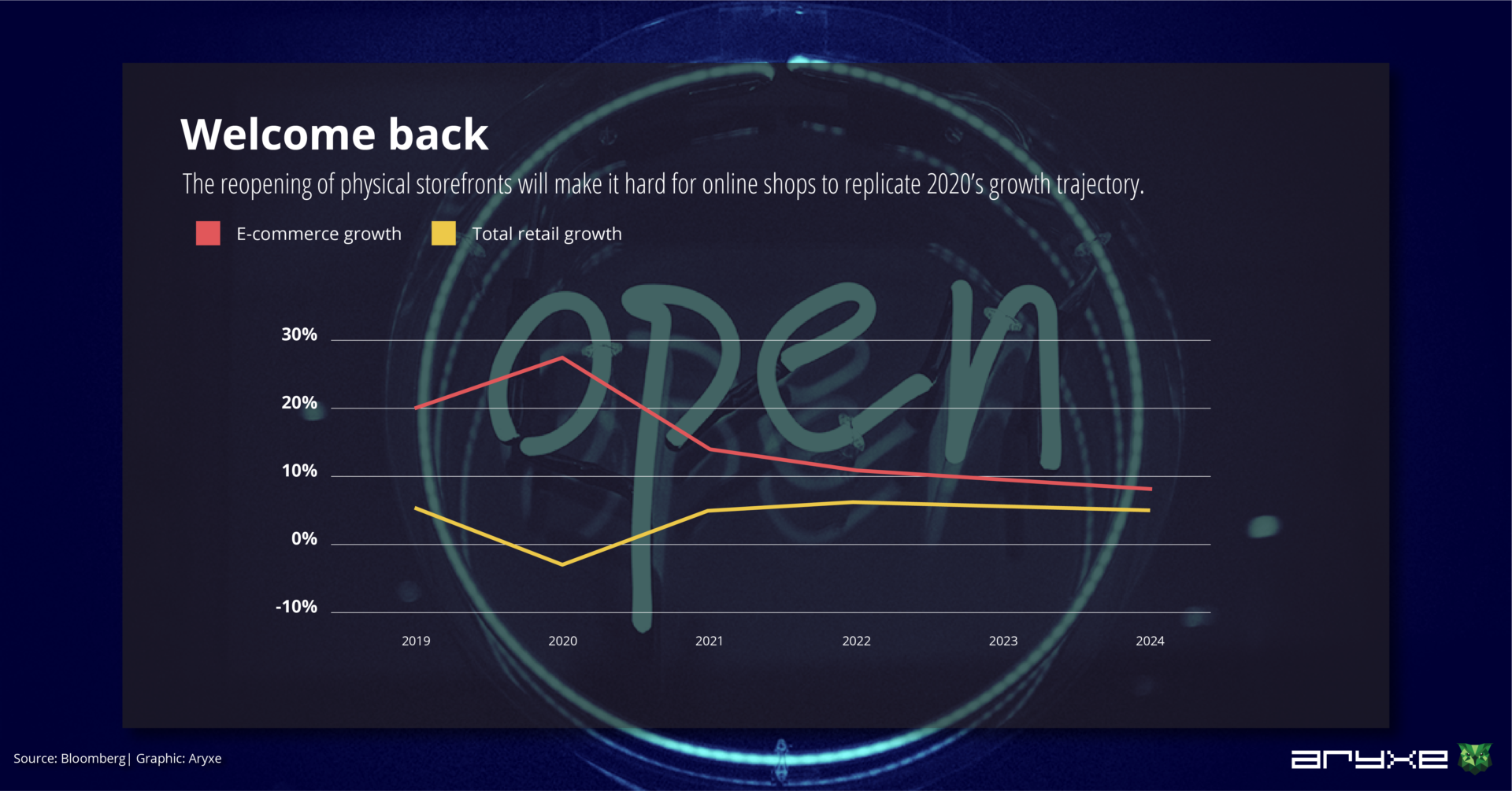
Although online clothing sales rose in 2020, it did far less than food and beverages, personal care, consumer electronics, and home furnishings, according to Bloomberg. This is in part due to people leaving their homes less often but it also has ties with the long-standing challenge in brands matching people to correct sizes. Even the size issue wasn’t that much of a problem during lockdown (it’s hard not to fit in sweatpants) but it will certainly resurface as one of the main shortcomings once people start needing new clothes.
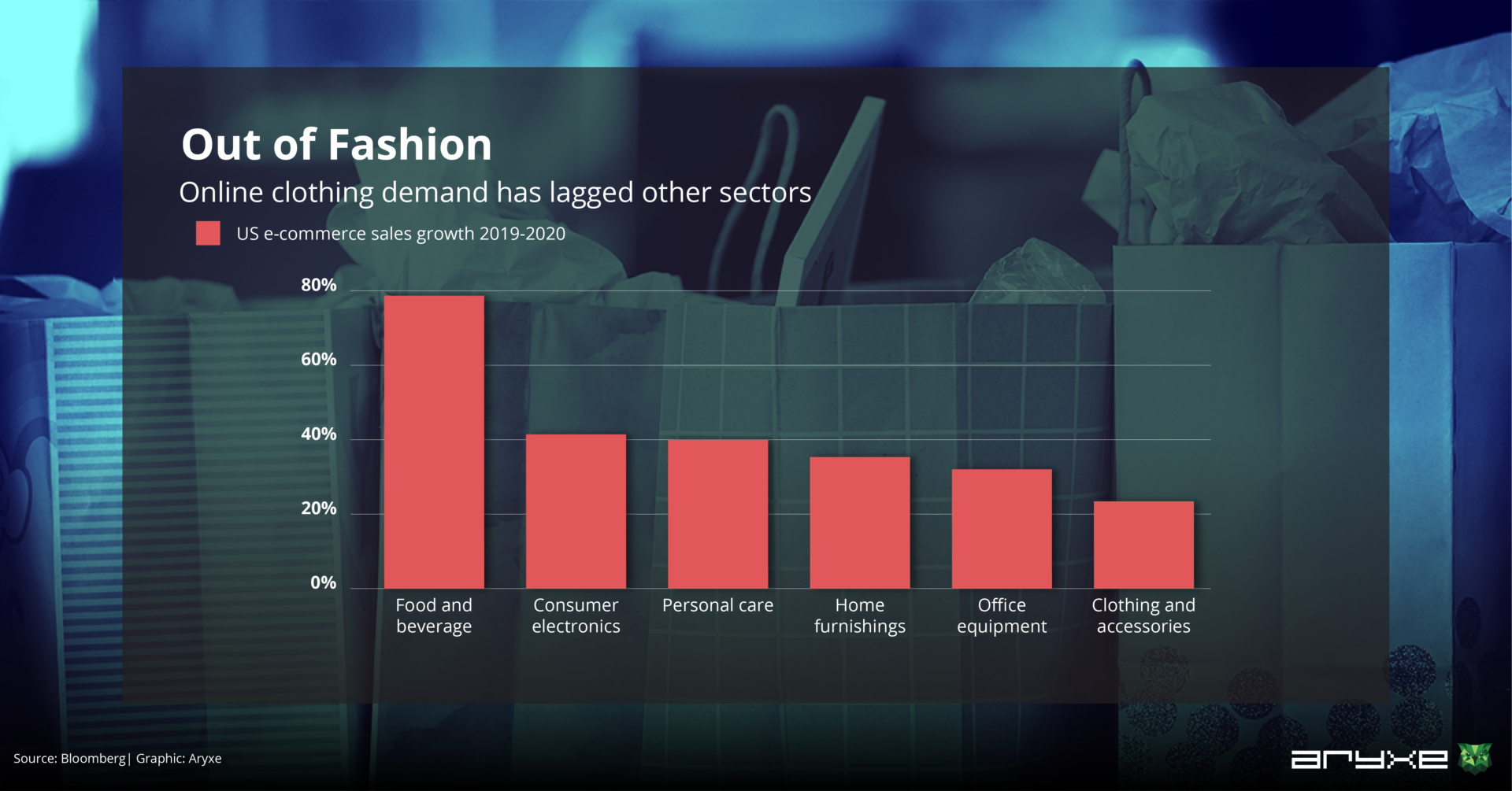
And maybe you think the issue with missing to match the size isn’t as relevant but let’s consider one example.
If you want to buy a new pair of sneakers and you order a $100 pair that turns out to be too small, you will try and return them and order the next size up. The second pair will not be dispatched until they receive the initial order that you are returning. So the company now has $200 of your money, you don’t have sneakers and it’s been almost a week of online communication with them. For many people, that’s just too much time spent on a cumbersome process and they would much rather go to the local store and return the sneakers and obtain the new pair in about less than 20 minutes.
Returns ought to become a question of taste rather than a question of fit and most companies have a lot to learn in order to get there. They can take those that invested in online selling before Covid-19. Some of those companies had an initiative where they would send an array of outfits to their customers, based on their style preference and then the customers would only pay for the pieces they decide to keep – which means that there is no waiting around for refunds. The companies will then take scores of measurements of each item and make their sense of the fit as accurately as possible. This entire process isn’t that difficult to coordinate and it pays out as it allows them to fine-tune each article of clothing to the body measurements provided by customers. And, perhaps this is not the most scalable process but it’s a step forward at least.
And, this surge in online shopping during 2020 also means that retailers now have a lot more data on hand to tailor their offerings and respond to their consumer’s preferences.
A growing number of shoppers are refreshing their wardrobes in physical retails again as they are also heading back to their offices and enjoying some outdoor and indoor dining, depending on the state they are living in, which is great news for fashion companies relying on physical stores but the comeback is probably short-lived.
The big names of department store chains said that they are reaping benefits from built-up demand among consumers after a year in which most of them stayed away from stores. These recoveries have also been aided by government stimulus payments injected in most sectors, including the ones that were forced to close.
According to the latest data from Mastercard’s SpendingPulse, which is tracking spending through credit cards, debit cards, and other payment methods at retailers, sales at department stores spiked significantly in April 2021 from the same time last year.

Shoppers are indeed happy to see stores reopen but they are reluctant to abandon online shopping as the recent survey has shown.
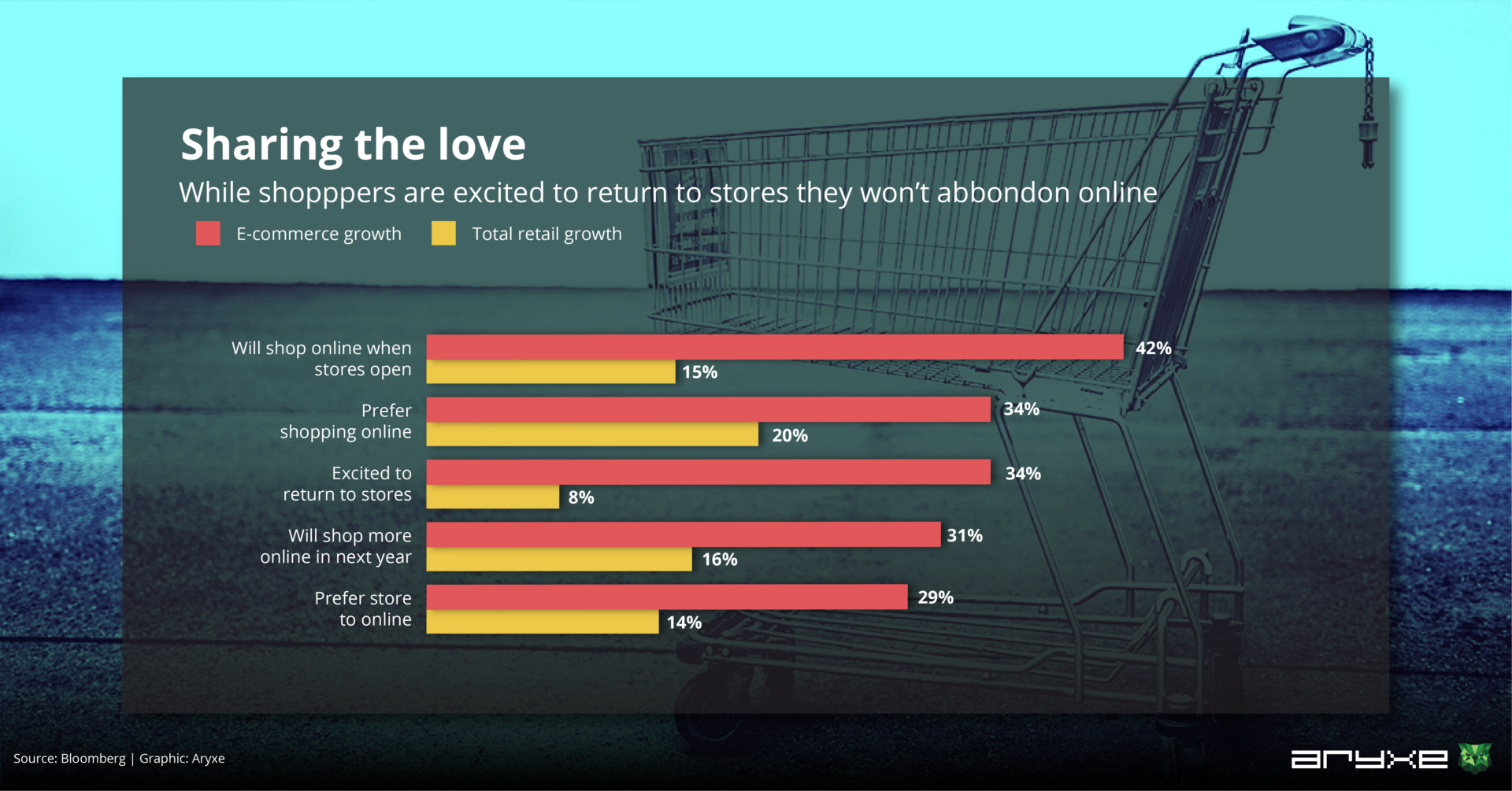
The reopening of the stores means that online companies need to think harder too. They will have to come up with new, imaginative ways of recreating the in-person shopping experience and provide a well-rounded service.
For instance, in luxury, the part of the excitement of visiting boutiques is the attentive service you receive. The moment you step your foot at Chanel or LV store, a salesperson literally caters to every single need you have, finding exactly the right product for you, taking payments almost seamlessly, and finally ensuring the packaging matches the sumptuous service. But even a glass of champagne as a cherry on top doesn’t mean that luxury brands are not feeling this shift. In fact, Bain & Co. estimates that as much as 30% of the personal luxury goods market will be digitalized by 2025. And it will be interesting to see how high-end groups will end up adapting to this shift, whilst maintaining a high-quality service.
The pre-coronavirus world was prolific soil for the luxury market which was living its best life thus far and enjoying a decade-long boom. This booming period of growth climaxed in 2018 when the luxury market reached an astounding $1.93 trillion and was expected to grow another 4.6% per year until 2025. Little did they know they needed to account for 2020 as the year of reckoning.
Luxury brands have been known for being very reluctant to embrace the age of digital prosperity and this is the decision that sent them reeling when we all started grappling with the pandemic in early 2020.
Relying on in-store experience and in-person service exclusivity, luxury brand leaders have long avoided using digital channels but once they were forced to face abrupt closures of brick-and-mortar stores, knowing that some of them won’t ever reopen, along with changes in customer demographics and newly adopted consumer behaviors, they found themselves expecting plunges and losses that represent a setback in a decade-long winning streak.
Accelerating their digital presence to compensate for the reduction of in-store shopping is an absolute must. In addition to that, brands should be adjusting their sales strategies and thinking of more ways to successfully position their products online now that they can’t pamper their customers in person. Ensuring that customers get the same level of luxury service they are accustomed to in physical stores is quite a challenge since you’ve got them used to sipping on champagne while the sales assistants are roaming around to find the absolute best fit. You simply can’t mirror that in an online service, so the leaders in this luxury brand market truly need to get inventive and they need to do it fast.
And don’t get us wrong, by no means are we saying that a luxury brand can’t be successful online, they just need to try harder. Tapping their toes in newly discovered waters, there have been some brands who have already had a taste of success using digital channels. For instance, Watches & Wonders dared to hold an online show where they had 800,000 viewers, and brands such as Panerai and Cartier were able to showcase 100 new models, which were successfully and hastily sold online after the events’ Livestream. Gucci went another step forward and launched a video service connecting their staff with viewers online, preparing us for the world of remote clienteling.
Being inventive, imaginative, daring, and backed up by good investment strategies, they can spice things up online, too.
The year 2020 is a great example of our inability to predict future events but there are some glimpses of change in consumer behavior dictated, induced even, by the pandemic. An obvious one is where experts foresee that the coronavirus pandemic will accelerate shoppers buying more of their clothes online than going back to the in-store shopping experience. Online-only retailers couldn’t be happier for this but they also generally haven’t suffered the same downturn as their competitors who still heavily rely on physical stores for most of their sales, which means that those competitors will need to invest a lot more in building up their digital operations than they have probably hoped for.
Another expected prediction says that loungewear will not stay as neglected as it once was. A lot of brands didn’t genuinely care about the way you looked at home and they were much more concerned about your “outside clothes”. Well, now that they have seen their customers’ inability to use the pavement catwalk at all times to present their carefully curated combinations, fashion brand leaders found themselves desperately grappling at the seams of indoor wear as a new source of creativity. In this sense, the shopping experience may become more well-rounded as you can buy a wider variety of clothing pieces from your favorite brand as they turn to caring for how you look while working from home.
One more shift that’s become even more visible during the Covid-19 pandemic is the shift towards sustainability in fashion. Sustainable fashion stands for protecting the future of our planet and its people while the clothes are being designed, created, and worn. To achieve that, clothing manufacturers need to carefully manage their resource use so that they reduce waste and are mindful of climate impact, thus protecting the welfare of animals, ensuring the safety and treatment of workers, and educating their customers on the best possible options when it comes to choosing more sustainable clothing. The latter might seem as though it is out of control of the ones making clothes but empowering shoppers to be aware of the impact of brands is key to achieving sustainability in fashion.
People are becoming ever more aware of the impact clothing manufacturing companies have on animals and nature and although they have the desire to keep on shopping they are now shifting to more organic choices. Searches for “vegan leather” have increased by an astonishing 69% YoY, averaging at 33,100 online monthly searches, while searches for “faux leather” remain constant. What this information suggests is that customers are responding more positively to the keyword “vegan” rather than “faux”. Searches for “eco vegan leather” have also spiked over the past year, telling us that consumers are increasingly becoming conscious of the fact that not all vegan options are environmentally friendly.
In addition to that, searches for “organic cotton” have jumped by 23%, while “recycled plastic” has seen a 35% increase in interest since January 2020.
Meanwhile, searches for “leather” have decreased by 3.5% YoY and those for “real fur” have also slowed down, decreasing 85 YoY.
It’s evident that more and more people are becoming aware of the issues in fashion and are demanding change. In response to that, brands are taking action – they are reevaluating their social and environmental impacts and setting goals to do better and become better. Those that turn to being fully transparent with their shoppers, publishing information about their practices, and promoting sustainability will win this game. The ones that don’t adapt to the more sustainable path are running the risk of losing their market share.
There’s absolutely no way of sharing the recipe for success when it comes to combating the pandemic and making it to the finish line as a winner — but, what we can do is share some of the tips that every company wishes to stay afloat can adopt as mitigation strategies.
Numbers are not looking promising when it comes to the number of fashion retailers that have adjusted their e-commerce approach since the start of Covid-19. Almost half of them didn’t think to do that, despite a massive shift towards shopping online.
Consumers are wary of shopping in person, and they will keep a certain level of caution for the months and years that are to come. Meanwhile, online shopping is their chance for a more convenient and far safer way of shopping.
The growth of online shopping has been on a steady uprise over the past few years but the massive acceleration took place only after we were hit with the Covid-19 pandemic. The question is whether this momentum will stay in force even in the post-pandemic world.
The bottom line is businesses that were quick to adapt to the new reality of shopping, by expanding their online presence, enriching their website and apps, and going the extra mile to ensure a smooth shopping experience are the ones that are thriving thanks to the ability to convert the former in-store traffic to online traffic.
Brands that were able to widen their offer by adding what really mattered to all of us during the lockdowns, working-from-home, and all those pleas to shelter in place, such as face masks, loungewear, and activewear instead of their regular offer – are the ones to include in the list of those who are making an effort and being attentive to the consumers’ needs.
Experts say a portion of remote work is here to stay, so all those video calls and virtual gatherings are not going away and will keep making consumers more pragmatic in their approach to fashion.
Therefore, it shouldn’t come off as a huge surprise to learn that fashion retailers are seeing a spike in sales of the “waist-up” apparel, while pants and skirts went down nearly 30%. So, retailers can take this as a clear hint that they can focus a tad more on buying, selling, and advertising the waist-up fashion trend to meet consumers’ demand.
Bottom line is, as a retailer, you’ll need to work twice as hard to learn the hoops of the changed world in order to stay relevant. It’s extremely difficult to say when the Covid-10 pandemic will come to an end. It’s even more difficult to say whether or not the world will go back to where it once was. However, it’s safe to say that people will continue shopping one way or the other, and quite frankly, we’d like to see a balanced mix of both in-person and online shopping.
https://us.vestiairecollective.com/fashion-report/
https://www.mckinsey.com/industries/retail/our-insights/state-of-fashion
https://www.bigcommerce.com/blog/covid-19-ecommerce/#understanding-panic-buying-and-coronavirus
https://newsroom.paypal-corp.com/2020-09-11-COVID-19-has-Changed-the-Fashion-Industry
https://econsultancy.com/stats-roundup-the-impact-of-covid-19-on-ecommerce/
https://luxiders.com/covid-19-fashion-trends/
https://edition.cnn.com/2021/05/12/business/department-stores-macys-kohls-nordstrom/index.html
https://qz.com/1831203/how-covid-19-could-change-fashion-and-retail/
https://qz.com/1881980/covid-19-has-been-great-for-online-fashion-retailers/
https://www.lyst.com/data/2020-conscious-fashion-report/
You are currently viewing a placeholder content from Default. To access the actual content, click the button below. Please note that doing so will share data with third-party providers.
More InformationInput your email to get the latest news in your inbox. We promise not to spam.